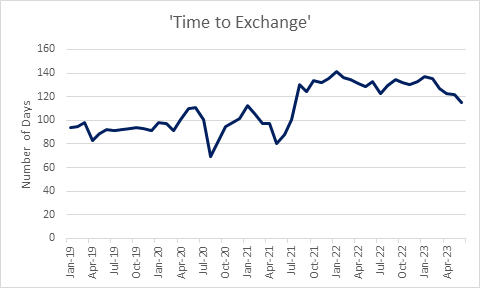Home buyers rejoice. The number of days it takes to exchange a house * in the UK is falling. TwentyEA has been observing time to exchange dropping steadily since February, allowing home movers to secure the keys to their new property faster.
The Waiting Game
Everyone knows that the housing market boomed in 2021, thanks to the stamp duty holiday and those working from home relocating to the country or looking for more space. Let’s not forget those historically low interest rates too – rates that home movers of today could only dream of. This increased demand in 2021 has since had a domino effect on how long it has taken for the whole house-moving process to complete. Conveyancers suddenly faced a substantial surge in their workload which inevitably caused a backlog.
The time taken to exchange grew significantly, and it has remained high ever since. The duration actually peaked at a whopping 141 days in January 2022. This left home movers facing a lengthy wait of 4.6 months to progress from Sold Subject to Contract to exchanging and moving in. A frustrating statistic for those eager to put down roots in their new property.

On the Move
We’re finally seeing this trend bucking. Stuart Ducker, Strategic Solutions Director of TwentyCi says, “In recent months - in fact since February 2023 - we have observed ‘time to exchange’ falling.” In June 2023, the average time to exchange in the UK was 115 days. This is the lowest point it has been since July 2021 - music to any potential home movers’ ears. In the last year alone, over 17 days have been wiped off the total time to exchange.
“In recent months, in fact since February 2023, we have observed ‘time to exchange’ falling.” – Stuart Ducker, Strategic Solutions Director

The Need for Speed
Reducing the time to exchange alleviates the stress and uncertainty experienced by both buyers and sellers during the waiting period. It also helps to keep the market dynamic, increasing efficiency with a smoother flow of properties entering and leaving the market. The buyer or seller may also benefit from cost savings from expenses tied up with the house exchange process, such as mortgage payments and utility bills. The quicker the transition occurs, the sooner these expenses can be minimised. It also has the benefit of stimulating market activity and improving market fluidity. This then has a ripple effect on industries such as construction, renovation, and home improvements. A more efficient property market inspires confidence amongst buyers and sellers, which leads to consumer spending, investment, and economic growth. It really is a win all-round.
What is Causing the Reduction in Time to Exchange Rate?
We attribute this reduction in time to exchange partly to the increase in the available supply of properties. Those selling their properties now have a much wider choice of where to move to. There has been a particular rise in mid to high-priced properties entering the market. The increased options of homes for buyers means that it is easier for them to find a property that they’re happy to move to once their current house goes from the For Sale stage to Sold Subject to Contract. When the availability of properties is limited, it can lead to a delay of several weeks before buyers find a property they are satisfied with, thus increasing the time it takes to form the chain.

Faster Times Ahead?
Whilst it is a promising trend, we need to consider that we still have a long way to go to match the time to exchange rates that we saw in pre-pandemic times. In June 2019, the average time to exchange was just 92 days. All eyes will be on reaching that 100-day mark. The good news is that the figure is falling, and we remain hopeful that the trend will continue throughout the year.
TwentyEA is part of the TwentyCi group. We are the number one provider of UK residential property data. We supply property data insights and residential property market analysis to estate agents. Compiled from over 29 billion qualified data points, we have the largest and most accurate information. We help estate agents to apply this data to generate more instructions. If you’d like to find out more, get in touch with us today.
*TwentyEA measures the ‘time to exchange’ by the lag in days between the last sale agreed date and the exchanged date.




-1.png?width=800&name=SOLD%20(1)-1.png)